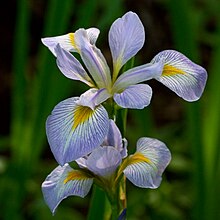
Back Iris virginica CEB Iris virginica Spanish زنبق ویرجینیا Persian ഐറിസ് വിർജിനിക്ക Malayalam Ирис виргинский Russian Iris virginica Swedish Iris virginica Turkish Iris virginica Vietnamese Iris virginica WAR
| Iris virginica | |
|---|---|

| |
| Scientific classification | |
| Kingdom: | Plantae |
| Clade: | Tracheophytes |
| Clade: | Angiosperms |
| Clade: | Monocots |
| Order: | Asparagales |
| Family: | Iridaceae |
| Genus: | Iris |
| Subgenus: | Iris subg. Limniris |
| Section: | Iris sect. Limniris |
| Series: | Iris ser. Laevigatae |
| Species: | I. virginica
|
| Binomial name | |
| Iris virginica | |
| Synonyms[3] | |
| |
Iris virginica, with the common name Virginia blueflag,[2] Virginia iris, great blue flag, or southern blue flag,[4] is a perennial species of flowering plant in the Iridaceae (iris) family, native to central and eastern North America.
It was identified as a separate species by Edgar Anderson, and is one of the three Iris species in Anderson's Iris flower data set, used by Ronald Fisher in his 1936 paper "The use of multiple measurements in taxonomic problems" as an example of linear discriminant analysis.[5][6]
- ^ Maiz-Tome, L. (2016). "Iris virginica". IUCN Red List of Threatened Species. 2016: e.T64315090A67729761. doi:10.2305/IUCN.UK.2016-1.RLTS.T64315090A67729761.en. Retrieved 29 November 2022.
- ^ a b NatureServe (30 June 2023). "Iris virginica". NatureServe Network Biodiversity Location Data accessed through NatureServe Explorer. Arlington, Virginia: NatureServe. Retrieved 2 July 2023.
- ^ "Iris virginica". World Checklist of Selected Plant Families. Royal Botanic Gardens, Kew. Retrieved 13 April 2015 – via The Plant List. Note that this website has been superseded by World Flora Online
- ^ "Lady Bird Johnson Wildflower Center - The University of Texas at Austin". www.wildflower.org.
- ^ R. A. Fisher (1936). "The use of multiple measurements in taxonomic problems" (PDF). Annals of Eugenics. 7 (2): 179–188. doi:10.1111/j.1469-1809.1936.tb02137.x. hdl:2440/15227. Archived from the original (PDF) on 2011-04-12. Retrieved 2015-08-30.
- ^ Kleinman, Kim (1999). "His Own Synthesis: Corn, Edgar Anderson, and Evolutionary Theory in the 1940s". Journal of the History of Biology. 32 (2): 293–320. doi:10.1023/A:1004424810841. ISSN 0022-5010. JSTOR 4331526. S2CID 126829834. Retrieved 15 February 2022.

